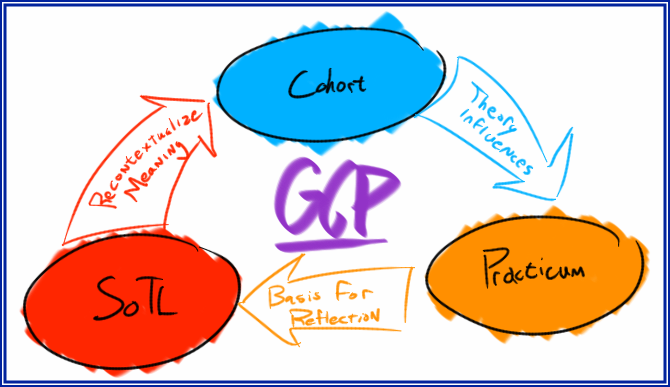Over the past few months, Shaya, Jessica, and I have been working on the Graduate Certificate Program in Higher Education. This is a Teaching Certificate offered by the Centre for Teaching, Learning, and Technology here at the University of British Columbia, intended to support graduate students who want to focus more deeply on developing as instructors. We’ve come a long way on the program since we started, and I’ll be updating on the development and launch periodically here, now that we have this lovely blog. Before that, I thought it might be nice to share a bit of background on the redevelopment of the program, and where we are in the development now.
The story so far…
This program is a redevelopment of the Grad Certificate Program that ran from 2007-2010. The focus of the program has been on helping graduate students who were aiming at future instructional faculty positions. There was a focus on both Scholarship of Teaching and Learning (SoTL) as well as work on how to apply theory and reflection to teaching practice. It was a very full program, and underwent a program review in 2010, just as major changes to our teaching centre were underway, projects got halted, and plans around the redevelopment have been in mothballs from then until about 6 months ago.
In that 6 months, we have been hard at work on redesigning the program. The basic structure of the new program grew out of the previous version of the Graduate Certificate Program, a number of conversations (especially with Catherine Rawn and Gillian Gerhard) as well as investigation and reflection on scholarship and articles on teaching, learning, and the future needs of faculty, students, and the university as a whole.
We are especially thinking about how instructors can help our students to start to “do” the discipline we are teaching – even if they don’t go on to further pursue that discipline as majors or practitioners. We end up drawing heavily on multiple theories, but especially transformative learning theory. This approach to teaching as a transformative process has application in familiar teaching spaces, but also extends the application of teaching into many other areas, including nonprofit work, advocacy, entrepreneurship, and the private sector. The ability to teach can help open new spaces and new opportunities to use disciplinary expertise outside their traditional fields of application.
The overall plan for doing this is to have a blended (face-to-face and online) cohort whose activities are closely integrated with a required practicum component in each term. The practicum component is, in turn, linked to a Scholarship of Teaching and Learning project to encourage reflective practice, which will help participants to further contextualize and make meaning of the theory they work on in the cohort.
Back in early January, the work the design team developed was brought to the Graduate Certificate Program Advisory Committee, which consists of highly recognized members of the teaching and learning community from across faculties and units at UBC. The feedback on the design was quite positive, and there were some valuable suggestions and insights which are already being incorporated into the design (to note one of many helpful conversations – the practicum component has been significantly redesigned, very much to the improvement of the program, the changes based on conversation in the advisory committee meeting).
Where we are now:
- We have developed high and mid level learning goals for the blended cohort
- We have developed an outline of the entire 3-term cohort
- We have designed an “open practicum” model to have a wide variety of opportunities for the application of theory.
- We have developed a program evaluation plan, and some of the evaluation instruments
- We have decided on the application process and timeline
There’s still a whole lot to do, including designing both the face to face and online lesson components, marketing the program, starting up the application process, and a whole lot more. But the project is really exciting, and something I think that we will be able to be quite proud of once it is finsihed.
